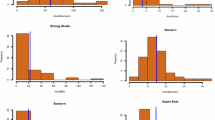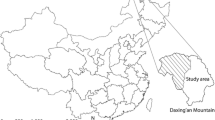Abstract
We used a spatio-temporal shot-noise Cox process to study the distribution of forest fires reported between 2006 and 2010 in the Mazandaran Province’s forests. The fitted model shows that daily temperature, altitude, and slope-exposure impacted fire occurrence. Forest fire occurred in the region had an aggregated behavior, which increased in radius below 1-km away from fired areas; a periodic pattern of fire occurrence in the region was verified. The risk of forest fire is significantly higher for areas with southern exposure and slope between 30° and 50°, northern exposure and slope between 0° and 50°, and eastern exposure and slope between 0° and 30°. The risk of fire was also significantly higher at altitudes between 1350 and 3000 m asl. Human causes were the main ignition source for forest fires in the region. The fire occurrence rate stayed above average during the drought period from September 2008 to September 2009. Our findings could lead to the development of fire-response and fire-suppression strategies appropriate to specific regions.





Similar content being viewed by others
References
Amatulli G, Peréz-Cabello F, de la Riva J (2007) Mapping lightning/human-caused wildfires occurrence under ignition point location uncertainty. Ecol Model 200:321–333
Ardakani AS, Zoej MJV, Mohammadzadeh A, Mansourian A (2011) Spatial and temporal analysis of fires detected by MODIS data in Northern Iran from 2001 to 2008. Proc IEEE Geosci Remote Sens Soc Conf 4:216–225
Azizi A, Yousofi A (2009) Foehan and forest fire in Mazandaran and Gilan provinces: a Case study for the forest fire from December 16–21, 2005. Geogr Res 24:2–228
Baddeley A, Turner A (2005) An R package for analyzing spatial point patterns. J Stat Softw 12:1–42
Baddeley A, Turner R (2006) Modelling spatial point patterns in R. Case studies in spatial point pattern modelling. Lect Notes Stat 185:23–74
BanjShafieia A, Akbariniab M, Jalalib G, Hosseini M (2010) Forest fire effects in beech dominated mountain forest of Iran. For Ecol Manag 259:2191–2219
Benavent-Corai J, Rojo C, Suárez-Torres J, Velasco-García L (2007) Scaling properties in forest fire sequences: the human role in the order of nature. Ecol Model 205:336–342
Bessie WC, Johnson EA (1995) The relative importance of fuels and weather on fire behavior in subalpine forest. Ecology 76:747–762
Brillinger DR, Preisler HK, Benoit JW (2006) Probabilistic risk assessment for wildfires. Environmetrics 17:623–633
Chas-Amil ML, Touza J, Prestemon P (2010) Spatial distribution of human-caused forest fires in Galicia (NW Spain). In: Proceeding of the second international conference on modelling, monitoring and management of forest fires, pp 247–259
Couce E, Knorr W (2010) Statistical parameter estimation for a cellular automata wildfire model based on satellite observations. In: Proceeding of the second international conference on modelling, monitoring and management of forest fires, pp 37–47
Dayananda PWA (1977) Stochastic models for forest fires. Ecol Model 3:309–313
Diggle PJ (1983) Statistical analysis of spatial point patterns. Academic Press, London
Diggle PJ, Rowlingson B, Su T (2005) Point process methodology for on-line spatiotemporal disease surveillance. Environmetrics 16:423–434
Food and Agriculture Organization (FAO) (2002) General status of the food and agriculture statistics in Iran. Available at: www.faorap-apcas.org/docs/05Iran/No.2IRA.pdf
Food and Agriculture Organization (FAO) (2010) Global forest resources assessment 2010. Available at: www.fao.org/docrep/013/i1757e/i1757e.pdf
Gralewicz NJ, Nelson TA, Wulder MA (2011) Spatial and temporal patterns of wildfire ignitions in Canada from 1980 to 2006. Int J Wildland Fire 21:230–242
Guyette RP, Muzika RM, Dey DC (2002) Dynamics of an anthropogenic fire regime. Ecosystems 5:472–486
HassanNayebi Esmail (2003) Identifying and combating with different fires in forest. Extensional Programmes Institute, Tehran
Jiang Y, Zhuang Q, Mandallaz D (2012) Modeling large fire frequency and burned area in canadian terrestrial ecosystems with poisson models. Environ Model Assess 3:1–12
Khosroshahi M, Ghavami S (2005) Hoshdar book. Publications of Forest and Rangelands, Tehran
Larjavaara M, Kuuluvainen T, Rita H (2005) Spatial distribution of lightning-ignited forest fires in Finland. For Ecol Manag 208:177–188
Mahdavi A, Fallah Shamsi SR, Nazari R (2012) Forests and rangelands’ wildfire risk zoning using GIS and AHP techniques. Casp J Environ Sci 10:43–52
Majidi E, Sobhani K, Rezaei MR (2011) Deforestation of forests in Iran. J Appl Environ Biol Sci 1:184–186
Martínez J, Chuvieco E (2003) Tipologías de incidencia y causalidad de incendios forestales basadas en an’alisis multivariante. Ecología 17:47–63
McKenzie D, Peterson DL, Agee JK (2000) Fire frequency in the interior Columbia River basin: building regional models from fire history data. Ecol Appl 10:1497–1516
Mermoz M, Kitzberger T, Veblen TT (2005) Landscape influences on occurrence and spread of wildfires in Patagonian forests and shrub lands. Ecology 86:2705–2715
Mohammadi F, Shabanian N, Pourhashemi M, Fatehi P (2010) Risk zone mapping of forest fire using GIS and AHP in a part of Paveh forests. Iran J For Poplar Res 18:586–595
Møller J, Diaz-Avalos C (2010) Structured spatio-temporal shot-noise Cox point process models, with a view to modelling forest fires. Scand J Stat 37:2–25
Møller J, Waagepetersen RP (2004) Statistical inference and simulation for spatial point processes. Chapman and Hall/CRC, Boca Raton
Møller J, Waagepetersen RP (2007) Modern statistics for spatial point processes. Scand J Stat 34(4):643–684
Peng RD, Schoenberg FP, Woods J (2005) A space-time conditional intensity model for evaluating a wildfire hazard index. J Am Stat Assoc 100:26–35
Pew KL, Larsen CPS (2001) GIS analysis of spatial and temporal pattern of human caused wildfire in the temperate rain forest of Vancouver island Canada. For Ecol Manag 140(1):1–8
Prestemon JP, Butry DT (2005) Time to burn: modeling wildland arson as an autoregressive crime function. Am J Agric Econ 87:756–770
Ripley BD (1976) The second-order analysis of stationary point processes. J Appl Prob 13:255–266
Ryan KC (2002) Dynamic interactions between forest structure and fire behavior in boreal ecosystems. Silva Fennica 36:13–39
Stoyan D, Stoyan H (2000) Improving ratio estimators of second order point process characteristics. Scand J Stat 27:641–656
Tirandaz M, Eslami A (2012) Zoning droughts and wetness trends in north of Iran: a case study of Guilan province. Afr J Agric Res 7:2320–2327
Turner MG, Romme WH (1994) Landscape dynamics in crown fire ecosystems. Landsc Ecol 9:59–77
Wang Y, Anderson KR (2010) An evaluation of spatial and temporal patterns of lightning- and human-caused forest fires in Alberta, Canada, 1980–2007. Int J Wildland Fire 19:1059–1072
Yang J, He HS (2007) Spatial patterns of modern period human caused fires in Missouri Ozrak highlands. For Sci 53:1–15
Acknowledgments
The authors would like to thank Dr. Akhavan for his suggestions. Constructive reviewers’ comments are much appreciated.
Author information
Authors and Affiliations
Corresponding author
Additional information
The online version is available at http://www.springerlink.com
Corresponding editor: Yu Lei
Rights and permissions
About this article
Cite this article
Najafabadi, A.T.P., Gorgani, F. & Najafabadi, M.O. Modeling forest fires in Mazandaran Province, Iran. J. For. Res. 26, 851–858 (2015). https://doi.org/10.1007/s11676-015-0107-z
Received:
Accepted:
Published:
Issue Date:
DOI: https://doi.org/10.1007/s11676-015-0107-z




